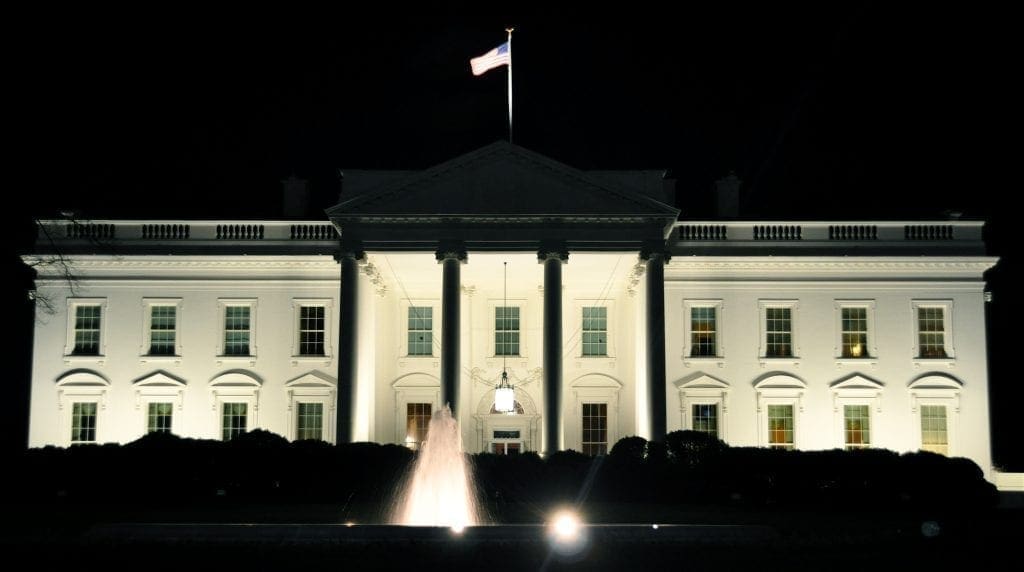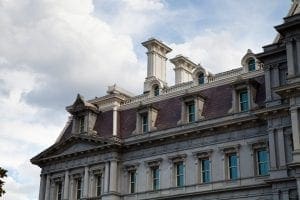
A photo of the north side of the White House at night by Kevin Burkett
COVID-19: What Went Wrong, A Timeline
Disasters rarely happen overnight. They start with a series of unfortunate incidents but take bad planning and poor decision making to grow.
January 2017
The first drill

The first thing that went wrong with the COVID-19 response was before the current administration even took office. About a week before Inauguration Day, the Obama White House lead a Principal-Level Transition Exercise in an attempt to ensure a professional transition of government as President Bush did.
Secretaries and other high-level officials were walked through a response to a simulated disaster picked by President Obama Homeland Security and Counterterrorism Adviser. The disaster they thought was most important to run through? An “[o]utbreak of novel influenza” that overwhelmed medical services in parts of Asia.
Unfortunately, some administration members reportedly slept through this exercise and of the thirty Trump appointees who attended, 70% have been fired or otherwise left the administration.
Despite the clear warning, President Trump said this month, “just think this is something, Peter, that you can never really think is going to happen.”
May 2018
Closing the pandemic office
After the Ebola epidemic of 2014, the National Security Council established the Directorate for Global Health Security and Biodefense. Better known as the Pandemic Response Team, they were responsible for preparing for and preventing the next epidemic or pandemic and alerting those who needed to know when there was a problem.

Almonroth/Wikimedia Commons
President Trump defended health cuts in February saying, “I’m a businessperson. I don’t like having thousands of people around when you don’t need them. When we need them, we can get them back very quickly.” He also said that the offices “hadn’t been used for many years.”
Dr. Anthony Fauci, NIAID Director, said it “would be nice if the office was still there.”
The President said when asked about the office’s elimination, “when you say me, I didn’t do it” and “I don’t know anything about it.” He went on to blame Dr. Fauci though the office did not fall under his jurisdiction, only under the White House and NSC.
Senator Sherrod Brown criticized this decision in a May 2018 letter on the same day that Senators Murray and Warren sent their own. Twenty-two Senators did the same in a joint letter dated mid-February 2020.
Due to the elimination of this office, the White House did not respond rapidly to the Novel Coronavirus outbreak and only began responding when it had already begun spreading uncontrollably throughout the United States.
October 2019
The second drill
Almost three full years after the initial drill, the Assistant Secretary for Preparedness and Response, Dr. Robert Kadlec, started his own exercise and involved 300+ partners, including the State of New York. This exercise was the aptly named Crimson Contagion. In a document repeatedly labeled “do not distribute”, the Assistant Secretary detailed some of the issues with the response.

- “Exercise participants lacked clarity on federal interagency partners’ roles and responsibilities during an influenza pandemic response.”
- Two secretaries submitted “briefs to the White House National Security Council during the exercise, which caused confusion regarding the official source of senior leader briefs.” The briefs contained inconsistent information.
- “Inconsistent use of terminology” on vaccines confused “all levels of government.”
- A “medical countermeasure supply chain” failure and resulting shortage during a pandemic. N95 respirators and ventilators would be issues because “they are often manufactured overseas.”
- The Department of Health and Human Services’ Operating Divisions and Staff Divisions put out “inconsistent and inaccurate response guidance and actions to healthcare and public health private sector partners.”
- “HHS’ regional staff lack clear guidance on the distribution of federal information management products to state and local partners.”
More directly for our community, it was also found that “states were less likely to implement guidance from CDC without first receiving notifications that emergency funding through the Stafford Act was approved.” Sweet Home Schools did not close until after this National Emergency/Stafford Act declaration.
The vast majority of the problems found in both the first and second drills were not addressed and have persisted in the real-life response to COVID-19. Because of this
December 2019/January 2020
The outbreak
On December 31st, 2019, the World Health Organization was notified of cases of pneumonia with no known cause.
Chinese authorities identified a new type of coronavirus and isolated it on January 7th, 2020. China shared the genetic sequence of the virus for countries to use for making tests.

On January 17th, the World Health Organization published instructions for making a test. On February 5th, the CDC announced they would start shipping 160,000 tests. A day later the WHO announced it had already shipped 250,000. On March 1st, an investigation was launched into the CDC test kits as they were faulty and would have to be remanufactured. States, including New York, began to seek approval from the FDA for their own tests.
Because of a lack of tests, it was difficult to control the spread of the virus. Because health officials were unable to know who did and did not have this disease, quarantine attempts failed and community spread began.
The CDC no longer publishes the number of tests performed. Unofficial numbers show that there are 695 tests per million people nationwide compared to 3,156 in New York. This is a contributing factor in the high number of cases in New York.
Despite all this, there are examples of foresight and good planning in government.
In 1997, Richard Preston’s book The Cobra Event was published. Its 432-pages head an outsized impact. After being read by President Clinton and a more official study being done into the risks it exposed, a solution was formed. Fifty-one million dollars, Congress said, “shall be for pharmaceutical and vaccine stockpiling activities at the Centers for Disease Control and Prevention[.]”
This grew into the multi-billion dollar Strategic National Stockpile and has been used to treat victims of Anthrax attacks and to respond to hurricanes. It has also been helpful in the response to COVID-19, especially due to the N95 masks in-store and will prove crucial in the future due to its ventilators.
The United States has proven capable of mitigating incidents and stopping them from becoming disasters through good planning and impeccable coordination, as during the 2009 H1N1 Pandemic. Chicago, LA and NYC alone have, during COVID-19, more than tripled the national peak school dismissal number of H1N1.
It can also create disasters out of incidents when, as during 9/11, agencies are on different frequencies. NBC New York reported that “Sept. 11 was a convergence of the worst possible problems in communication technology — a jammed commercial network made cell phone use impossible. Police and firefighter radio networks were not compatible.” This is believed to have caused the deaths of approximately 400 first responders who did not know when to evacuate the building.
Rarely is an elected official or government truly responsible for an incident, firsthand. However, they are secondhand responsible when their incompetence and laziness turns the situation into a disaster, being at fault for the lives lost as a result.
Want more information? Visit coronavirus.gov or Erie County’s webpage. The Panther Eye will continue to deliver rapid updates by Twitter and Instagram on this crisis and the district will update the school community on its webpage.

Chukwudi, better known as Chudy, has been Editor-in-Chief since his sophomore year and has worked on the newspaper since his freshman year. His main focus is editing of articles, social media, and managing the website.
